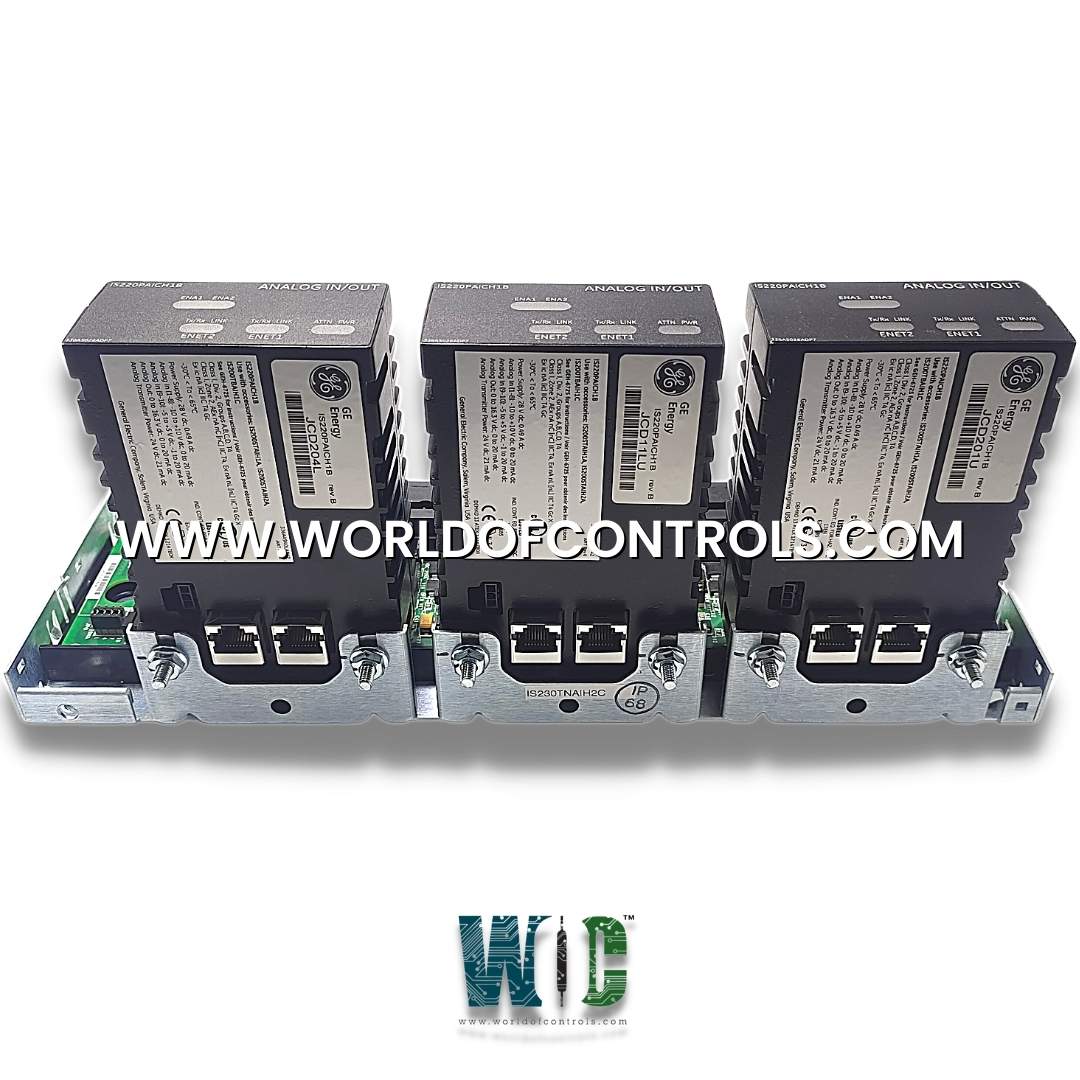
World Of Controls understands the criticality of your requirement and works towards reducing the lead time as much as possible.
IS230TNAIH4C - Analog I/O DIN-Rail Module is available in stock which ships the same day.
IS230TNAIH4C - Analog I/O DIN-Rail Module comes in UNUSED as well as REBUILT condition.
To avail our best deals for IS230TNAIH4C - Analog I/O DIN-Rail Module, contact us and we will get back to you within 24 hours.
SPECIFICATIONS:
Part Number: IS230TNAIH4C
Manufacturer: General Electric
Series: Mark VI
Product Type: Analog I/O DIN-Rail Module
Input Signal Types: 4–20 mA, 0–10 V, ±10 V
Output Signal Types: 4–20 mA, 0–10 V
Output Resolution: 12-bit to 16-bit
Isolation Voltage: 1500 VDC
Power Consumption: 3–6 W
Input Resolution: 16-bit
Input Channels: 4, 8, or 16
Signal Accuracy: ±0.1%
Operating Temperature Range: -20°C to +60°C
Size: 15.9 cm high x 17.8 cm
Weight: 0.8kg
Repair: 3-7 days
Availability: In Stock
Country of Origin: United States
FUNCTIONAL DESCRIPTION:
IS230TNAIH4C is an Analog I/O DIN-Rail Module manufactured and designed by General Electric as part of the Mark VI Series used in GE Speedtronic Gas Turbine Control Systems. An Analog I/O DIN-Rail Module is a signal interface device designed to facilitate communication between analog field devices and control systems such as PLCs (Programmable Logic Controllers) or DCS (Distributed Control Systems). These modules are used to acquire analog signals from sensors (e.g., pressure transmitters, temperature sensors, flow meters) and deliver analog output signals to actuators (e.g., control valves, I/P converters, VFDs). The module is mounted on a standard DIN rail inside a control cabinet and typically supports industry-standard analog signal ranges such as 0–10 VDC, ±10 VDC, and 4–20 mA. It performs analog-to-digital conversion (ADC) for inputs and digital-to-analog conversion (DAC) for outputs, enabling the control system to interpret and act on physical process values. Signal isolation, noise filtering, and high-resolution data acquisition are standard features for robust industrial performance.
OPERATION:
These signals are sampled and converted into digital values using high-resolution ADCs, commonly 12-bit to 16-bit, and transmitted to the control processor via a backplane or communication bus. Each channel is often independently configurable to accept either voltage or current input signals. Similarly, analog output channels receive digital command values from the control system, which are then converted into corresponding analog signals using DACs. Output signals typically range from 0–10 V or 4–20 mA, used to modulate actuators or drive analog indicators. Many modules also incorporate fault detection, such as open-loop detection on current outputs and overrange/underrange alarms on inputs. Modules are often equipped with diagnostic LEDs indicating channel status, power presence, and fault conditions.
INSTALLATION:
The module should be installed in a well-ventilated environment free from high electromagnetic interference and temperature extremes, typically rated for operation between -20°C and +60°C. Once mounted, field wiring is connected to terminal blocks, which may be pluggable or fixed depending on the module model. Each analog input or output channel is individually wired according to the wiring diagram provided in the module’s datasheet, with careful attention to signal polarity and grounding. The module may draw operating power from a 24 VDC supply or the I/O rack backplane, depending on design. Configuration may be hardware-based using DIP switches or software-based through a connected controller or engineering tool. Once installed, proper shielding and cable segregation must be maintained to minimize signal noise, particularly when dealing with low-level analog voltages.
COMPATIBILITY:
The Analog I/O DIN-Rail Module is fully compatible with GE Speedtronic turbine control systems, specifically the Mark V, Mark VI, and Mark VIe series. These modules are typically used within GE's distributed I/O architecture to interface analog signals from process instrumentation with the turbine control logic. In the Mark VI and Mark VIe systems, Analog Input and Output modules are often installed in the DIN-rail-mounted I/O packs, such as the AIHA (Analog Input High Level), AOHA (Analog Output High Level), and TBAI/TBAO (Terminal Board Analog Input/Output) assemblies. Analog modules in these systems are designed to:
WOC maintains the largest inventory of replacement parts for GE Speedtronic Gas Turbine Control Systems. We supply both unused and rebuilt components, each covered by a warranty. In addition, we offer expert repair services for malfunctioning boards. Our team of automation specialists is available 24/7 to support your OEM needs. For parts, repairs, or technical assistance, please contact us via phone or email. We are committed to providing prompt and reliable support.
What types of analog signals can the module handle in GE Speedtronic systems?
The Analog I/O DIN-Rail Modules in GE Speedtronic systems are capable of handling both voltage and current signal types. Common input ranges include 4–20 mA current loops and 0–10 V or ±10 V voltage signals.
How do these modules communicate with the Mark VI or Mark VIe controller?
In the Mark VI system, analog I/O modules communicate with the controller through the VME backplane in a centralized I/O rack, while in the Mark VIe system, DIN-rail mounted I/O modules are distributed and connect over the IONet, a high-speed, deterministic Ethernet-based network.
What are the power supply requirements for the module?
Analog I/O modules typically operate on a 24 VDC power supply, with a nominal input range between 18 to 30 VDC. Power may be provided directly through a separate supply or via the I/O rack backplane. The power consumption varies between 3–6 W, depending on the number of channels and signal processing requirements.